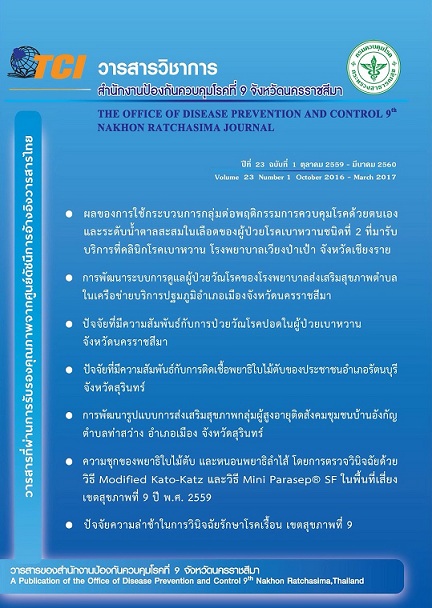Effects of Group process programs on Self-Care Behavioral and Accumulated Blood sugar level of Diabetes Mellitus Patients at Wiang Pa Pao Hospital, Chiangrai Province.
Abstract
The purpose of this experimental research was to study the effects of group process programs
on self-care behavior and accumulated blood sugar level (HbA1c) among diabetics patients. Using theory
of self care, behavioral modi cation and group process. Eighty patients of diabetes mellitus type 2 at diabetes
clinic, Wiang Pa Pao Hospital were were selected by simple random sampling and equally assigned
into 2 groups : 40 experimental and 40 control groups. The research instruments were participation
learning group is consisted of building knowledge, awareness of self care among diabetics patients :
eating behaviors, appropriately exercise, foot care and medication adherence. Data were collected
using self-care behavior questionnaires. The reliability of the questionnaires in knowledge used
Kuder-Richardson[KR-21] was equal to 0.97 and self-care behavior used Cronbach’s Alpha was
equal to 0.71. Data were analyzed by using Descriptive statistic, Paired t-test and Independent t-test.
The results showed that after the experimental group had an average score of self-care behaviors
better overall than before the experiment and better than the control group. It was statistically
signi cant (p <0.001). And later found that the experimental group had an average score of eating
behavior, appropriately exercise, foot care and medication adherence are better than before the experiment.
It was statistically signi cant (p <0.001). The average level of accumulate blood sugar (HbA1c)
in the experimental group after the trial was lower than before and better than control group. It was
statistically signi cant (p <0.001). The results of this study indicated that the group process programs
can be used to promote self-control behavior for the others diabetic patients. We can be applicable
this program to patients with other chronic non-communicable diseases .
References
โรคเบาหวาน 2557. พิมพ์ครั้งที่ 2. กรุงเทพฯ: ห้างหุ้นส่วนจำกัด อรุณการพิมพ์; 2557.
2. สำนักโรคไม่ติดต่อ. เอกสารรายงานสถิติโรคปี 2557. สำนักโรคไม่ติดต่อ กรมควบคุมโรค กระทรวง
สาธารณสุข. นนทบุรี: 2557.
3. Black JM, Matassarin-Jacobs. et al. A Psycological approach. 4th ed. Philadelphia: W.B.
Saubders; 1993.
4. Pickup JC, Willium G. Text book of Diabetes. 2nd ed. London: Blackwell Science Editorial
Off i ce; 1997.
5. เทพ หิมะทองคำ, วัลลา ตันตโยทัย, พงศ์อมร บุญนาค และคณะ. ทบทวนองค์ความรู้เกี่ยวกับเบาหวาน
และนํ้าตาลในเลือดสูง: กระทรวงสาธารณสุขและมูลนิธิสาธารณสุขแห่งชาติ; 2547.
6. Nathan DM, Kuenen J, Zheng H, et al. Translating the A1C assay intoestimated average glucose
value. Diabetes Care 2008. 2008;31(8):1473-8.
7. กล่มงานผู้ป่วยนอก โรงพยาบาลเวียงป่าเป้า จังหวัดเชียงราย. เอกสารสรุปผลการดำเนินการโรคเบาหวาน
ปีงบประมาณ 2556. เชียงราย: 2556.
8. กลุ่มงานผู้ป่วยนอก โรงพยาบาลเวียงป่าเป้า จังหวัดเชียงราย. เอกสารสรุปผลการดำเนินการโรคเบาหวาน
ปีงบประมาณ 2557. เชียงราย: 2557.
9. กลุ่มงานผู้ป่วยนอก โรงพยาบาลเวียงป่าเป้า เชียงราย. เอกสารสรุปผลการดำเนินงานโรคเบาหวาน
ปีงบประมาณ 2558. เชียงราย: 2558.
10. เทพ หิมะทองคำ และคณะ. ความรู้เรื่องเบาหวานฉบับสมบูรณ์. พิมพ์ครั้งที่ 7. กรุงเทพฯ: วิทยาพัฒน์
การพิมพ์; 2548.
11. ฉวีวรรณ บุญสุยา. สถิติสำหรับงานวิจัยสาธารณสุข. กรุงเทพฯ: เสนาการพิมพ์; 2551.
12. กัลยา วานิชย์บัญชา. การใช้ SPSS for WINDOWS ในการวิเคราะห์ข้อมูล. พิมพ์ครั้งที่ 11. กรุงเทพฯ:
บริษัทธรรมสารจำกัด; 2551.
13. วิมลรัตน์ จงเจริญ, วันดี คหะวงศ์ และคณะ. รูปแบบการส่งเสริมการดูแลตนเองเพื่อควบคุมระดับนํ้าตาล
ในเลือดของผู้ป่วยเบาหวานชนิดที่ 2. สงขลานครินทร์เวชสาร. 2551;6(1):71-84.
14. ศุภวดี ลิมปพานนท์. ประสิทธิผลของโปรแกรมการส่งเสริมสุขภาพต่อการเปลี่ยนแปลงพฤติกรรมของผู้ป่วย
เบาหวาน โรงพยาบาลพหลพลพยุหเสนา จังหวัดกาญจนบุรี [วิทยานิพนธ์]. นครปฐม: มหาวิทยาลัย
มหิดล; 2537.
15. วิชัย ฟักผลงาม และคณะ. ผลการให้สุขศึกษาและการปรับพฤติกรรมการดูแลตนเองของผู้ป่วยเบาหวาน
โรงพยาบาลรามาธิบดี. รายงานการวิจัยคณะแพทยศาสตร์ โรงพยาบาลรามาธิบดี มหาวิทยาลัยมหิดล.
2535.
16. สมพร สาดแสงธรรม. ปัจจัยที่มีความสัมพันธ์กับภาวะนํ้าตาลในเลือดของผู้ป่วยเบาหวาน ชนิดไม่พึ่งอินซูลิน
ในคลินิกผู้ป่วยเบาหวาน โรงพยาบาลพระนครศรีอยุธยา [วิทยานิพนธ์]. กรุงเทพฯ: มหาวิทยาลัย
เกษตรศาสตร์; 2548.
17. ศุลีพันธ์ มาแสวง. ประสิทธิผลโปรแกรมส่งเสริมสุขภาพและสุขศึกษาในการปรับเปลี่ยนพฤติกรรมและควบคุม
ระดับนํ้าตาลในเลือดของสตรีวัยทองที่ป่วยเป็นเบาหวานชนิดที่ 2 โรงพยาบาลจตุรพักตรพิมาน จังหวัด
ร้อยเอ็ด [วิทยานิพนธ์]. นครปฐม: มหาวิทยาลัยมหิดล; 2554.
18. ชดช้อย วัฒนะ. ผลของโปรแกรมการจัดการตนเองเกี่ยวกับโรคเบาหวานต่อความรู้เกี่ยวกับโรคเบาหวาน
การควบคุมระดับนํ้าตาลในเลือด ภาวะเสี่ยงต่อโรคหัวใจและหลอดเลือด และคุณภาพชีวิตของผู้ที่เป็น
โรคเบาหวาน [วิทยานิพนธ์]. เชียงใหม่: มหาวิทยาลัยเชียงใหม่; 2549.
19.วจี ภักดีดินแดน. ศึกษาการเปลี่ยนแปลงระดับนํ้าตาลในเลือดของผู้ป่วยเบาหวานชนิดที่ไม่พึ่งอินซูลิน
ภายหลังเข้าร่วมการใช้กระบวนการกลุ่ม. วารสารวิชาการเขต 4. 2551;10(2):283.
20. เจษฎา จงไพบูลย์พัฒนะ. การประเมินประสิทธิผลของการใช้กระบวนการกลุ่มในการดูแลผู้ป่วยเบาหวาน
ของโรงพยาบาลสตูล. วารสารวิชาการเขต 12. 2556;14(2):45-50.
21. อนันต์ ซินดือเระ. ผลของการให้สุขศึกษาเพื่อการปรับเปลี่ยนพฤติกรรมต่อการควบคุมระดับนํ้าตาลในเลือด
ในผู้ป่วยเบาหวาน อำเภอยะหริ่ง จังหวัดปัตตานี. วารสารวิชาการเขต 12. 2551;19(1):33.

Published
How to Cite
Issue
Section
License
บทความที่ลงพิมพ์ในวารสารวิชาการสำนักงานป้องกันควบคุมโรคที่ 9 จังหวัดนครราชสีมา ถือว่าเป็น
ลิขสิทธิ์ สำนักงานป้องกันควบคุมโรคที่ 9 จังหวัดนครราชสีมา



